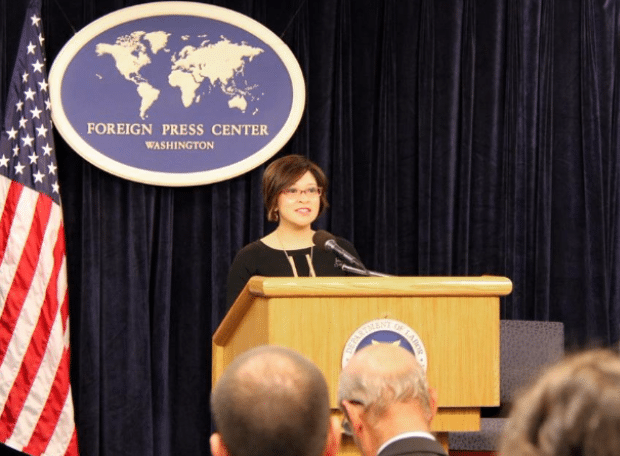
Sweat & Toil — an App that Matters
BY PAKSY PLACKIS-CHENG
Charita Castro: Chief of Research and Policy; Office of Child Labor, Forced Labor and Human Trafficking; Bureau of International Labor Affairs; U.S. Department of Labor
The Office of Child Labor, Forced Labor and Human Trafficking launched an app named Sweat & Toil, available on iTunes and Google Play! impactmania had a chance to sit down with Charita Castro, who leads a team that produced more than 1,000 pages of research that form the foundation of the app.
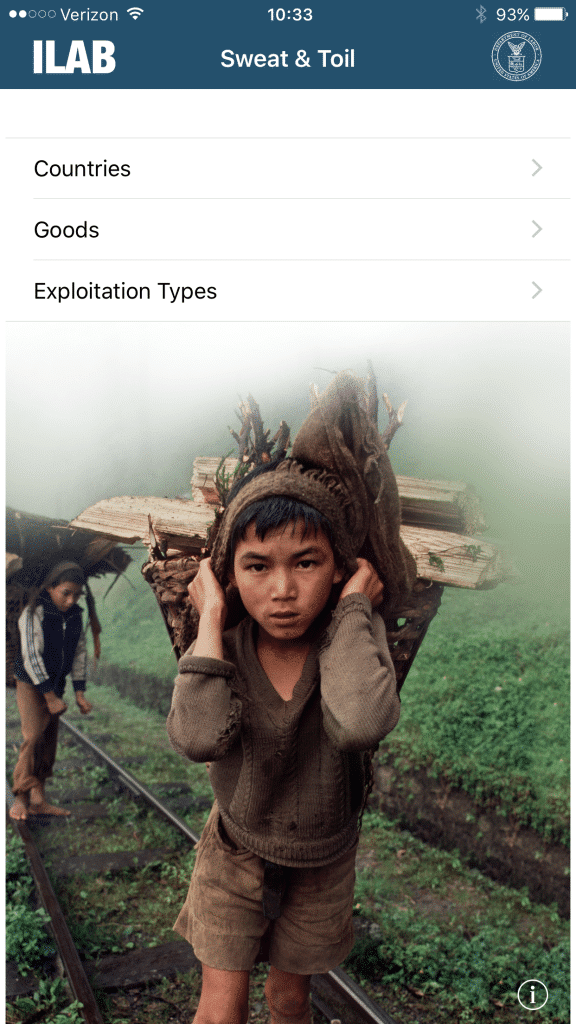
The Sweat & Toil App
What do you do?
First and foremost, my job is to be a manager, a supervisor. I have a team of about 20. The other aspect of my job is to provide my team the tools, resources and space to carry out any presidential directives or legislative mandates related to research… [and then also] to make recommendations to my director and leadership on different policies affecting child labor, forced labor, or human trafficking internationally.
Our office also funds technical assistance projects around the world to provide viable alternatives to child labor and forced labor, including through education and training … my Division oversees projects that seek to build the capacity of countries to address child labor or forced labor, whether it’s through legislative reforms, enforcement actions, policy development, or social programs. We also provide technical assistance to countries to collect data to inform the development of policy or programs.
One of the most important tasks that my division works on is the research, development and publishing of three flagship reports on child labor and forced labor internationally.
Tell me a bit about these flagship reports.
We have three flagship reports on child labor and forced labor. Our reports are essentially tools for how we work together as a global community to improve the lives of children. When we bring well-researched, quality reports, we are able to work with governments in a collaborative way that is based on data that is transparent.
If you’re committed to the sciences, you have an obligation to apply a certain rigor, methodology… a systematic way of viewing and communicating the data in the most responsible way. It’s about providing objective information to inform decision making and encourage action. We are able to approach governments in a collaborative way that lets them know that we have shared objectives in addressing exploitation and ensuring the well-being of children. For our engagement with countries to be successful, it is important that our reporting is evidence-based… That’s something that our office takes pride in. When our office was started in 1993, it was with the primary mandate to research and report on these labor rights violations.
Why these issues?
My mom and dad are from the Philippines. My dad was from a rural land-rich family, grew up with 13 siblings, and all had the opportunity for a college education. My mom was from an urban poor family, raised by a single mom because her dad passed when she was in the 6th grade, and they really had to struggle… some of my aunties and uncles even had to work when they were children. They are from Tondo, which is a district of Manila. When you say that to another Filipino, they’ll always follow up with, “Your mom must be siga.” Siga means fighter or tough.
It was important for my mom that my brother and I spend time in her childhood home. When we lived in Japan, most of our summers and winter breaks, that’s where we stayed. Being in the Philippines is where I learned about what poverty looks like…I experienced not having running water and then seeing kids on the streets begging. With this exposure, my parents instilled in me a sense of not taking the blessings we had in life for granted.
Why do you like working with data, and how did you end up in a place that seems to be a perfect fit?
One of the reasons I love math so much is probably because of the women science and math teachers in my life…After 30 years, I still keep in touch with Pamela Trombley-White who taught me how fun math could be. I also started taking sociology classes. My professor was Laura Sanchez, and I am still in touch with her today. She taught us about gender and racial inequality, and introduced me to research methods. It was combining social issues with math and the research process; I fell in love with that.
Then, I happened to intern under Wendell Primus, who was then the Income Security Division Chief at the Center on Budget and Policy Priorities. I didn’t know he was this big wig in the Health and Human Services and domestic welfare policy community in D.C. This is where I learned in D.C. you can work until 11 p.m. at night. He would do testimonies on the Hill and then be booked for speaking events after. On one occasion I had to pick him up on the Hill and he said, “Okay, meet me there; here are the keys to my car.” I’m not a good driver at all, and I’m short! I was driving around D.C., and I couldn’t see, so I’d be on a phonebook!
Going to social work school, I didn’t take enough quantitative classes, and Primus was really honest with me: “… If you want to do this type of policy research, you need more quantitative skills … so you either need to go back to school, or you need to find a job where you get those skills.”
I took it as a challenge. I was applying at the same time to the Presidential Management Fellowship and a doctoral program in public policy at George Washington University. I got both. Another mentor of mine at the U.S. Census Bureau, Stephanie Shipp, who was hiring said, “Well you don’t have to choose one or the other. We’ll support you to go to school and work.”
At the Census Bureau if you’re doing data — a testament to the Census Bureau — it is just about the numbers. The Census Bureau is where I got a solid foundation for my data skills.
Child poverty issues are always what I had been working on. As I researched child poverty more and more, child labor in the Philippines kept coming up. I happened to meet another Presidential Management Fellow at a training who worked in my current office at Department of Labor. I couldn’t believe that an office like this existed, and I figured out a way to get a rotation in this office. At the same time I continued my doctoral studies, which focused on child labor.
Why the Sweat & Toil app?
The development of this app has always been a team effort. As our office strengthened research, documentation, and analysis of the contents of the report, I was realizing there were all these discreet variables that we could report on. We just began developing a system to capture the data. We didn’t know how exactly we would format the data, but we did know that we wanted to make it more accessible to the public.
We have a Chief of Innovation Officer at Department, and the Obama Administration had set up this Presidential Innovation Fellowship. These Presidential Innovation Fellows were connected to a group to help fix healthcare.gov. It was amazing; these fellows who come from the tech industry are assigned to federal agencies and are dedicating their time and skills for the public good.
They took our data and pitched to us what they could do, and so we were working hand-in-hand in the design, all the way to the level of what these icons would look like, what the icons meant.
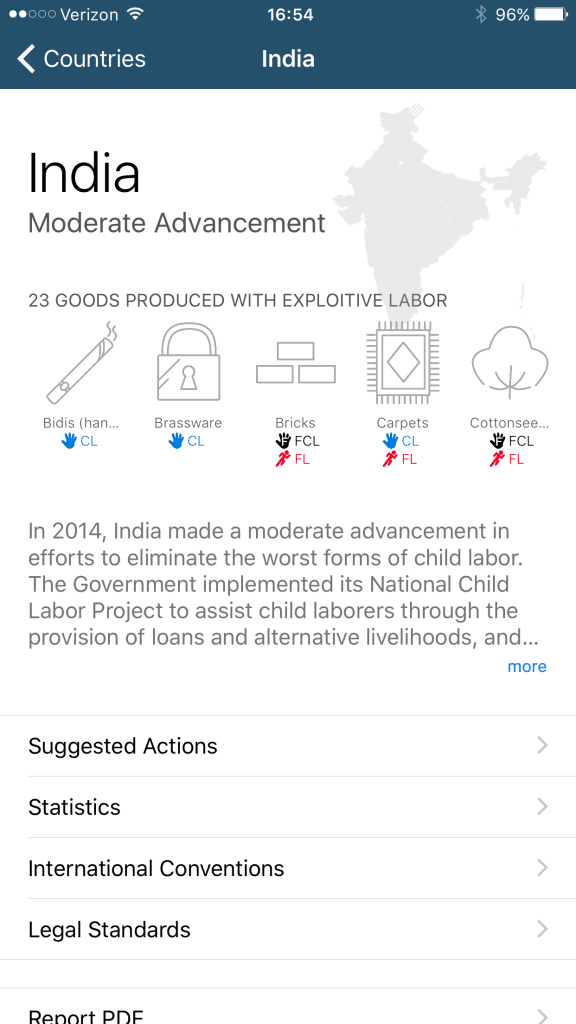
We wanted to make sure the app had the greatest utility for key stakeholders. We had different user stories, including questions various industries would want to see. For example, “What countries are involved in child labor in the production of sugarcane?”
What are some simple steps people can take to support the end of child labor?
Our app is meant for the public to ask questions, take action, demand change. We want people to ask more questions about how workers are treated around the world. These workers produce goods that we consume and render services that we benefit from. We need to ask the right questions like, “Where does the coffee I drink every day come from? Are the companies that I’m buying it from aware of their supply chains? Do they care about it?” For us, it’s all about raising awareness about the child labor and forced labor so that we can all work together for change. We want to provide people with information so they can be a voice for others who do not have a voice for themselves.
What are some of the surprising facts about child labor that you came across that maybe the community doesn’t know about?
Some people think that children are either working or in school. The reality is that children often do both – they work so that they can afford to go to school because uniforms or schoolbooks aren’t free. In some countries, if parents don’t have the money to pay for school fees and supplies, the children can’t complete their schooling. People may also be surprised about the work that children are doing — the fact that children are working in gold mines and going down in shafts, or are in bonded labor or slave-like situations in the production of bricks or cotton.
Over the years, there has been much more awareness around sex trafficking, and that’s really great. Awareness on labor trafficking is also increasing…girls are trafficked from rural to urban areas to work as domestic servants at a very young age in private homes. They work around the clock and often experience verbal, physical, and even sexual abuse.
Some of what we have seen in the field — you almost couldn’t imagine children continuing to be abused in this way. When I went to the field for the first time, I was doing a site visit to an area in the Philippines known for child prostitution. It was early —like dawn had just come — and then young girls lined up almost like execution style. I could see from the cab foreigners pointing to the kids.
How old would the children be?
We’re talking girls as young as 7 or 8. I just lost it. The sight of children being sold into prostitution was too much for me to witness. I remember going back to my hotel room, calling my mom, and just crying.
Do you think things are changing for the better?
Definitely. Global statistics from the International Labor Organizations show that from 2000 to 2012, there are 78 million less child laborers in the world….168 million down from 246 million.
We’ve had a great advocate over the years— Senator Tom Harkin from Iowa was a champion for child laborers around the world. With the resources our office has been given, we’ve been able to support numerous organizations working on this issue. Twenty years ago, these organizations were not focusing on child labor.
I actually got to travel with Senator Harkin to see former child carpet weavers in Pakistan. This has been one of the highlights of my time in the office….to see how the funding appropriated by the U.S. Congress is having a positive impact on the lives of children and families around the world.
What is needed for social impact?
I think it’s a shared understanding of our humanity. There is an African term for that called ubuntu. When we realize another person’s suffering is also our suffering, then that can spur others to take action. I think that’s something that my mother really taught me. I grew up in a Catholic family. For me, what it means to have faith, at the end of the day — whether you’re a Christian, Buddhist, or Muslim — it all comes down to love, what it means to love one another.
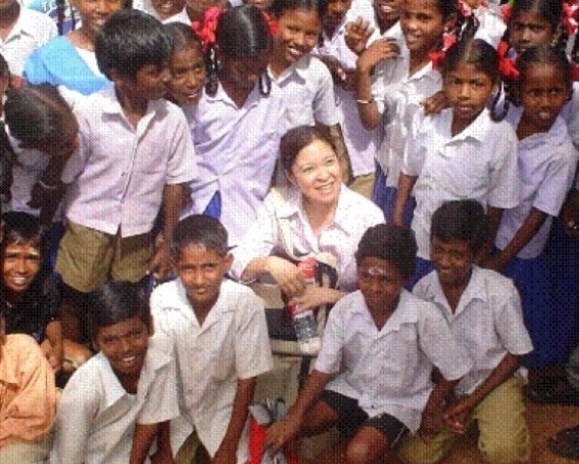
Charita Castro on a field visit to India in November 2006.
The reason I’m in this office is not only because there is no other agency in the federal government that does this, but also because I’m also part of a great team…we have shared values about ensuring workers have rights and a voice in their workplace and are protected from abusive or exploitative working conditions.
What is it like to work for the government?
As a student of public policy, I like to put government work into a theoretical context. You have to have the kind of personality that understands that change is sometimes incremental. There are times I get frustrated, but you also realize you have to be in it for the long game… It really is about public service. Some people may say, “Why should the U.S. government be working in other countries when there’s a lot of poverty here?” I don’t think those things are mutually exclusive when we live in a connected world. Lack of opportunities and exploitation in other countries may have devastating effects for us – both in terms of economic, environmental, social, and security outcomes.
I think that you have to be positive. You have to realize that planting seeds takes time. You really have to be patient. And you have to be okay with bureaucracy… We have a fiscal year. Congress sets the budget. We have to realize there are things that are in our control and other things that are not in our control.
I also think it really is a true honor. You’re representing the U.S. government. It is a great privilege, and I never forget about that.
Why would young people consider working for the government?
Change happens from outside, and change also happens from within. What I’ve realized [is] that it is possible to make change from within. We all play a role. If they’re committed to public service and wanting to make a difference, this is such a great place to do it. It’s not to say that it’s the only place. I hope that people don’t get discouraged about what they see on the outside or how “the government” is portrayed. I think when some people speak negatively about the government or government workers, what they don’t see are the thousands of federal government workers that dedicate their lives to ensuring that workers get paid and are safe, that they don’t get discriminated in the workplace, and that children are not put in harm’s way.
There are highly qualified, smart people that I’ve learned from and who have committed their careers to public service. I hope that there’s more of an effort to be able to attract a new generation into government that brings their talents and experience to public service.
Who had an impact on your professional DNA?
I have had so many women with me along my journey. In addition to Pam, Stephanie, and Laura that I mentioned earlier, there’s Margaret King of Newcomb College at Tulane University. She saw leadership qualities in me. She nominated me for a public policy scholarship and selected me to attend a leadership conference in D.C. with President Clinton’s Interagency Council on Women and Girls. My doctoral dissertation advisor, Kathy Hunting, taught me how to have a sharp mind related to research and methodology.
Marcia Eugenio, who’s been my director for the last 15 years. She had confidence in me when I lacked confidence in myself. At each step of my career here in the office, whether it was giving me a leave of absence to do a Fulbright or leaving the office for academia, I could come to her at all these decision points in my career. I was also a very young supervisor…she taught me that it is okay to make mistakes, to learn from those mistakes, and to have courage in making unpopular decisions if they are necessary for accomplishing our goals.
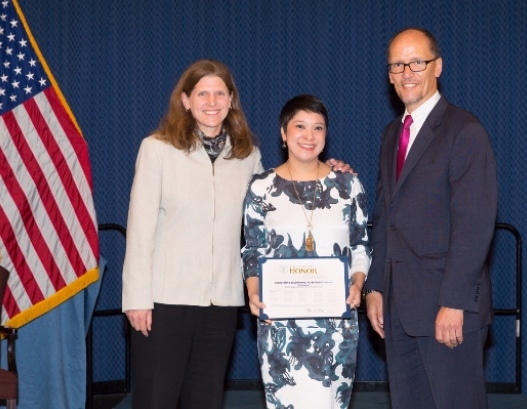
Charita with Deputy Undersecretary for International Affairs Carol Pier and Secretary of Labor Thomas E. Perez accepting an Exceptional Achievement award on behalf of the office for their work on making the Findings of the Worst Forms of Child Labor report a more useful policy tool.
Give me a word that would describe your journey so far.
My gosh, one word… Grateful. On my best days, I’m all about love. I love my job, I love my coworkers. I also have a husband, Theo, that I love, and he supports me in every way so I can do what I love. And so, yeah, I’m just grateful that I get to do what I love every day.
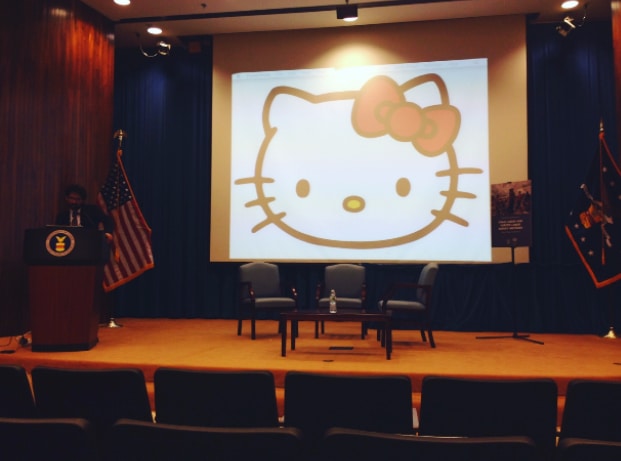
During the January 2016 snowstorm that shut down the Washington, D.C. region, U.S. Department of Labor was hosting a training on child labor and forced labor survey methods with colleagues from the International Labor Organization. Due to the snow, conference services staff was running behind, and Castro’s personal computer was needed at the last minute. With no time to change her wallpaper and and nowhere to hide, she owned her Hello Kitty Super Fan status.
____________________________________________________________
Charita Castro, PhD at George Washington University’s School of Public Policy and Public Administration; MSW at Washington University in St. Louis and Bettie Schroth Johnson Women in Management Scholarship; U.S. Fulbright Scholar to the Philippines for child labor research, 2004-2005; and BS with honors from Tulane University/Newcomb College.
The Sweat and Toil app can be downloaded from Apple iTunes and Google Play. You can check countries’ efforts to eliminate child labor and review goods produced with child or forced labor.



